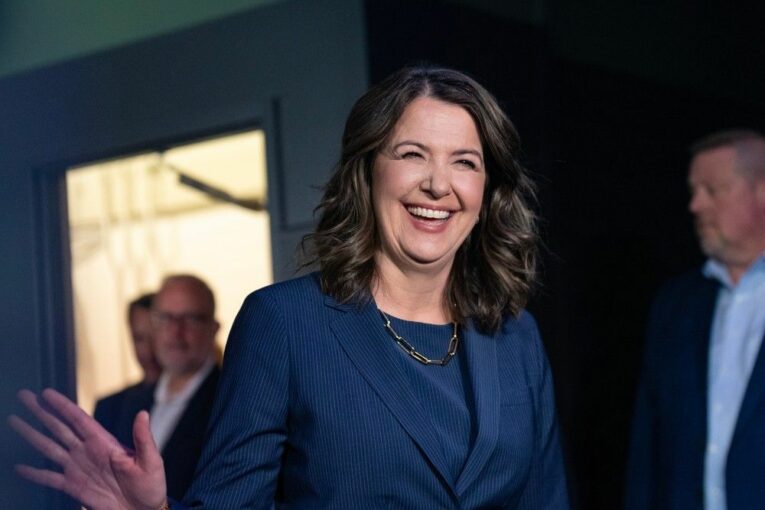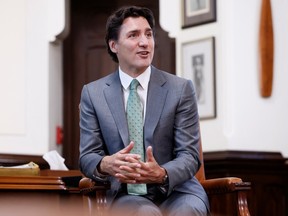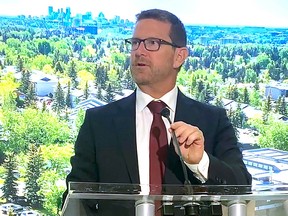
Grab a seat and get ready, the next round of the Alberta-Ottawa energy war is set to begin.
At the end of her victory speech Monday, UCP Leader Danielle Smith lobbed a few verbal grenades toward Ottawa over its contentious energy policies.
The incoming federal emissions cap on the oil and gas sector and Justin Trudeau’s government’s plan for a net-zero electricity grid by 2035 are now squarely within the crosshairs of Smith’s newly re-elected government.
“As premier, I cannot under any circumstances allow these contemplated federal policies to be inflicted upon Albertans. I simply can’t and I won’t,” she declared.
“I invite the prime minister to instead halt the introduction of these harmful policies and come to the table in good faith to work collaboratively with Alberta on an energy emissions strategy.”
These words, coming just moments after defeating the NDP in the 2023 general election, will stake out the next battle lines with the Trudeau government on energy: how to best decarbonize oil and gas production in Alberta this decade, and how to shift to a net-zero electricity system within a dozen years.
These are critical economic and environmental issues for a province that contains the world’s fourth-largest oil reserves, and an electricity system that leans on natural gas-fired generation to keep the lights on.
“It was really combative and she didn’t mention the sovereignty act, but I expect that is going to be used very quickly,” said Mount Royal University political scientist Duane Bratt said.
“Buckle up.”

The stakes are high for both sides.
The federal government has set a target to reach net zero by 2050, but doesn’t have a lot of time to reach its aggressive 2030 goals.
Its emissions-reduction plan projects a 42 per cent cut to oil and gas sector greenhouse gas emissions (from 2019 levels) by the end of this decade.
Smith argues this would effectively become a production cut.
The sector is the largest emitting industry in the country, although many companies have adopted net-zero targets, including the biggest oilsands producers.
Alberta needs to attract billions of dollars of investment into emerging areas of decarbonization, and federal and provincial co-operation will be required to make it happen.
Smith started off her victory speech Monday night by referencing former Progressive Conservative premier Ralph Klein in 1993, declaring: “Welcome to another miracle on the prairies.”
If we’re going to turn to the history books, it’s worth noting the many scraps that Klein had with the Liberal government of Jean Chretien over the Kyoto accord.
Yet, Klein’s government also made a deal in the 1990s with the federal government to create a new tax and royalty regime for the oilsands.
It sparked a wave of investment into the oilsands — an astronomical $262 billion in capital spending between 1996 and 2015 — and ignited a development phase that has generated billions of dollars in royalties and created thousands of jobs.
Business Council of Alberta president Adam Legge said the group is concerned with both the emissions cap and the net-zero electricity standard, calling them “flawed public policies.”
“What we’ve been encouraging the federal government to do is be flexible,” Legge said. “If they are going to be digging in their heels, then I think we are (in) for a significant battle.”
The next few months will show how wide the chasm between the two sides really is, as Ottawa moves forward with its oilpatch emissions limit and the incoming Clean Electricity Regulations.
In Alberta, purely gas-fired generation made up about 60 per cent of the province’s total installed generation capacity last year. Lowering emissions from such facilities will be necessary — but potentially costly.
Recommended from Editorial
-

Varcoe: Smith warns federal emissions cap will shut-in production
-

Varcoe: Canada marches ahead with cap on oilpatch emissions
-

Big $60B hit for Alberta in a net-zero world if Canada phases out oil and gas by 2050, study finds
-

Oilsands giants warn Canada falling behind U.S. on carbon capture incentives
Take city-owned Enmax Corp., which has about 1,500 megawatts of electricity generation capacity, with 1,300 MW coming from its gas-fired facilities.
The local utility is examining the feasibility of a carbon capture unit at its Shepard Energy Centre. It’s also looking at financial support available from the federal government to de-risk the technology.
“If the federal government wants to meet a policy objective of 2035, that shouldn’t go on the backs of ratepayers and Calgarians,” Enmax CEO Mark Poweska said Tuesday after the company’s annual meeting.
“We’ll be looking for how do we make it economical for our customers, while at the same time achieving policy goals?”

Similarly, the oilpatch isn’t looking for a rumble over federal policy, but it wants an open discussion between industry and both levels of government in the coming months.
“The bottom line is, there’s no technical way to meet that cap, the emissions cap, without cutting production,” Tamarack Valley Energy CEO Brian Schmidt said in an interview.
“I just think the cap was announced without really understanding the implications . . . The answer is collaboration.”
There are also major energy projects on the drawing board that are inching ahead, but will likely need a joint federal-provincial incentive program to make them economic and competitive with existing U.S. grants.
In Ottawa, federal Natural Resources Minister Jonathan Wilkinson told reporters he’ll work with Alberta to reduce emissions and build a strong economy.
“I’m not looking to pick a fight with Alberta or with Nova Scotia or British Columbia, I’m interested in working collaboratively,” he said.
The proof will come when the final rules and regulations on these significant policies are released and put into place.
The day after the election, Smith wasn’t giving an inch.
Speaking to QR radio host Shaye Ganam, Smith said she’d talk with the prime minister later in the day, but indicated Alberta is preparing for a clash over the net-zero grid requirement and the emissions cap.
“There’s a big fight coming up,” she said.
In other words, grab a seat.
Chris Varcoe is a Calgary Herald columnist.
You can read more of the news on source
